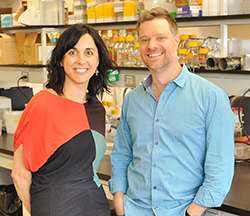Breakthrough helps explain how DNA is organized in our cells

A team of researchers at the IRCM led by François Robert, PhD, uncovered a critical role for two proteins in chromatin structure. Their breakthrough, recently published in the scientific journal Molecular Cell, helps explain how DNA is organized in our cells. This discovery could lead to a better understanding of what causes certain types of cancer, such as lymphoma.
Dr. Robert and his team study chromatin, the structure composed of DNA and proteins that makes up chromosomes. Its main role is to package DNA molecules containing all the organism's genes into the cell nucleus, which is approximately 20,000 times smaller than the DNA itself.
"This extreme compaction is made possible by proteins called histones, which condense the DNA much like thread is wound around a spool," explains Dr. Robert, Director of the Chromatin and Genomic Expression research unit at the IRCM. "Maintaining an appropriate chromatin structure is essential for normal development and, not surprisingly, defects in chromatin components can lead to several diseases."
Chromatin is carefully organized in such a way that genes remain "accessible" to the various proteins required for gene expression, or the interpretation of the genic information stored in DNA. Chromatin therefore provides the organism with another layer of information, referred to as epigenetic information, which is made available, in part, through specialized histones called histone variants.
"In our laboratory, we study one such histone variant called H2A.Z," says Célia Jeronimo, PhD, research associate in Dr. Robert's laboratory and first author of the study. "H2A.Z is located in specific regions of the gene called promoters, which are involved in controlling gene expression. It is known that H2A.Z is necessary for promoters to function properly."
"With this study, we discovered that two other proteins (FACT and Spt6) play an important role in the location of H2A.Z," adds Dr. Jeronimo. "In fact, we found that these proteins are essential to prevent an accumulation of H2A.Z in inappropriate regions of the gene, which leads to a disorganized chromatin structure."
The study also reveals that inhibiting the inappropriate positioning of H2A.Z is crucial to prevent gene expression defects called "cryptic transcription".
"Inappropriate H2A.Z localization has previously been observed in cancer cells, but little was understood about the consequences of this phenomenon," states Dr. Robert. "Although our study was performed in yeast cells, it suggests that mislocalization of H2A.Z may lead to cryptic transcription in some types of cancer such as lymphoma, and this may contribute to the disease. Our next step is therefore to investigate the possible role of H2A.Z and its associated gene expression defects in cancer cells."
More information: Molecular Cell: www.cell.com/molecular-cell/ab … 1097-2765(15)00221-X
Journal information: Molecular Cell
Provided by Institut de recherches cliniques de Montreal
















